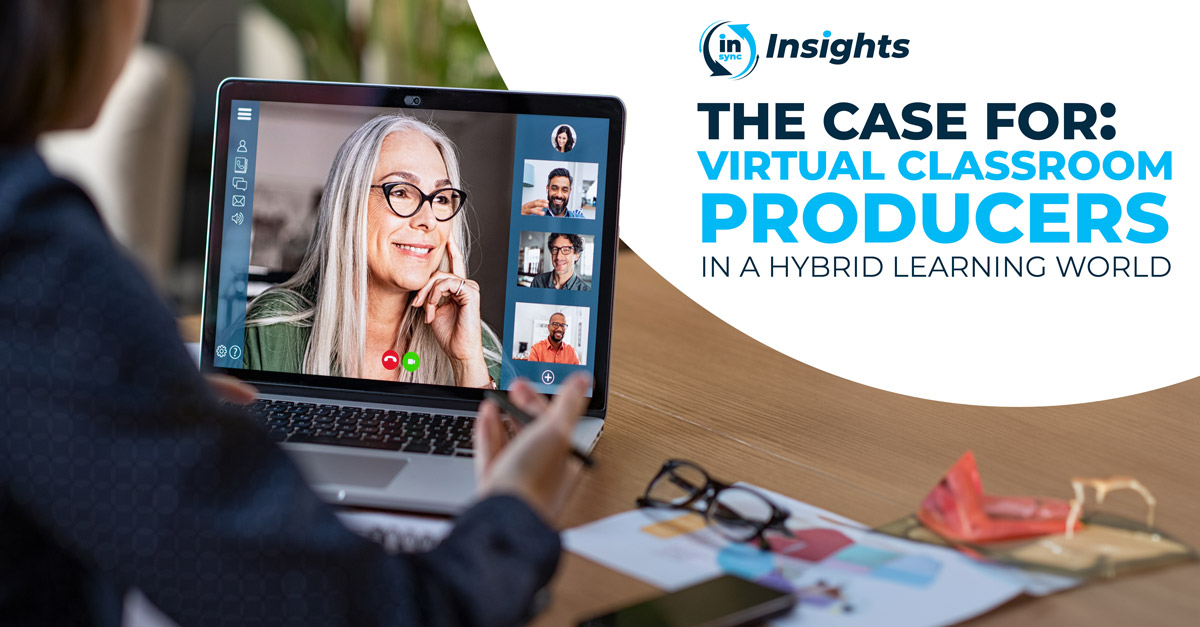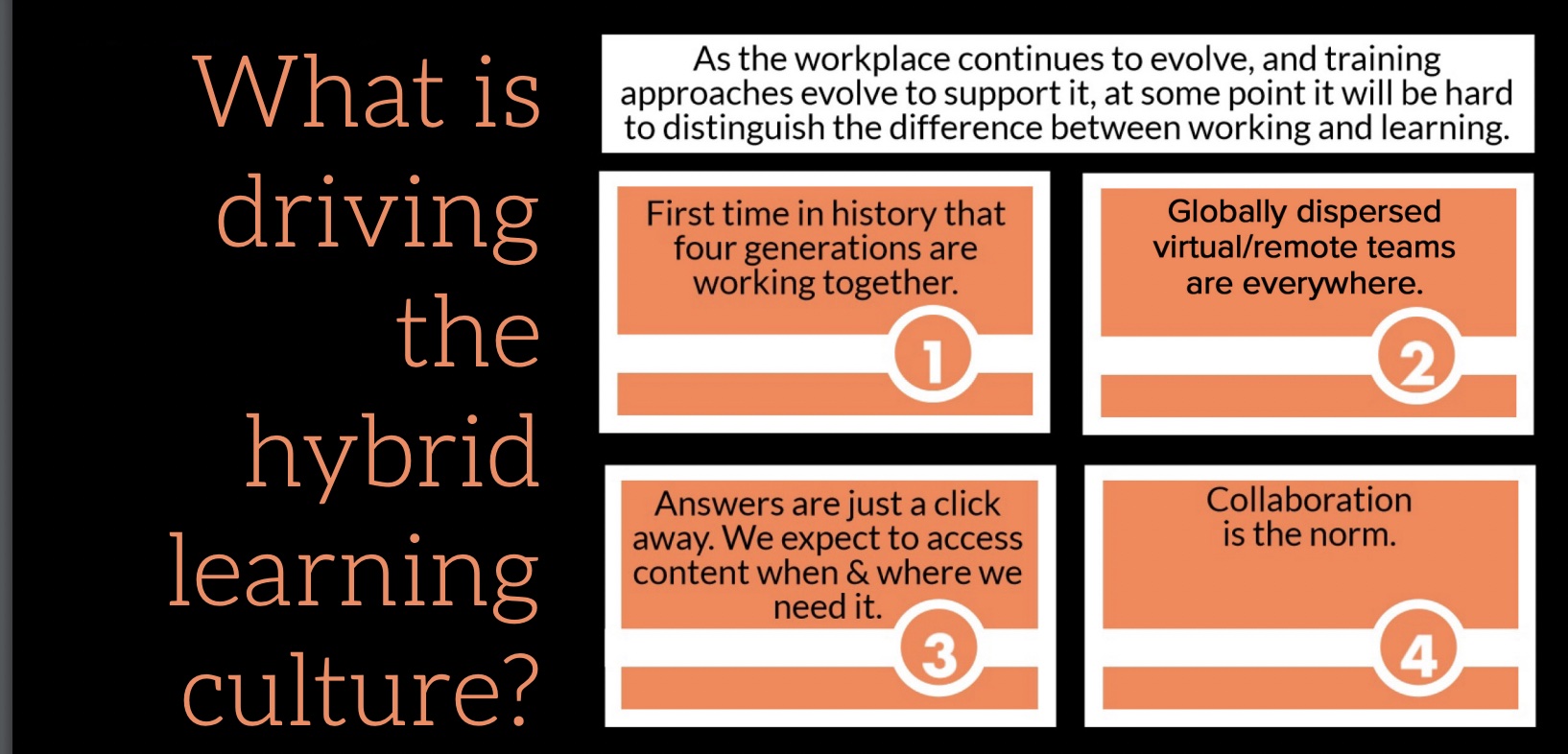4 min read
Hybrid Learning is the New Modern Blended Learning Solution
 Jennifer Lindsay-Finan
:
Aug 14, 2023 12:37:30 PM
Jennifer Lindsay-Finan
:
Aug 14, 2023 12:37:30 PM

A Hybrid Workforce Means Hybrid Training
Blended learning is about how the content is delivered. Hybrid learning is about where the participants are learning. Corporate learning strategies need to consider both.
Companies large and small are considering how the workforce will be distributed in this post-pandemic world. Gallup recently reported that about 53% of "remote-capable" employees expect a hybrid working arrangement, with 25% expecting to work entirely remotely.
With this trend in hybrid and remote work becoming more our "new normal," many organizations expect their learning and development teams to adopt the same approach.
What do we mean by "hybrid is the new blended"?
Let’s break down this concept of "hybrid is the new blended." When we talk about a hybrid model, we are really talking about the learner’s environment—where they are and how they’re interacting with the learning experience. Blended refers to BOTH the delivery technology and the content. It includes live classes (in person, virtual instructor led, or a combination) as well as other resources and activities that learners typically work through in a self-paced format.
In this modern workplace where our people are working in different environments every day (at home, in the office, or somewhere else) and are working at different times of day with a need to learn through various mediums, we need our learning programs to be both hybrid and blended.
What impact does hybrid blended training have on learner engagement?
When it comes to learner engagement, the key with hybrid training programs is to ensure that no learner gets left behind. Further, it's that every learner can fully participate and contribute to the learning experience, no matter where they are or what kind of device they’re joining on. When it comes to hybrid blended programs, it’s important to consider both the live classes and the rest of the blend.
Live hybrid classes
The biggest impact that live hybrid classes have on learner engagement occurs in the environmental dimension, since it's the environment itself that's different. Some learners will be in the same room as each other, thus experiencing the same learning environment, while others are joining from various remote locations with completely different set ups and surroundings.
Imagine the learners that are in the same physical space: their learning environment might consist of watching a presentation on a projector screen and listening through speakers. Perhaps they have a microphone on the middle of the table and maybe even a webcam trained on them. Perhaps they have teas and coffees and cakes on hand with pens and notebooks and sticky notes scattered around the room. Their environment may be shared with other colleagues working around them, or maybe they’re located in a training room so that they don’t need to think about how much noise they’re making.
Even though the experience is instructor-led, the environment is not the same as in face-to-face training. These learners are aware that they are being heard and maybe also seen by others who are not in the room with them. When it comes to engaging in the learning, they have to act differently. They can't just speak "normally" because the virtual participants won’t hear them well enough. They can’t just stand up and walk over to the coffee pot without the virtual participants wondering where they’re going. Nor is it the same as individual virtual training, as they can’t annotate on the whiteboard or ask questions in chat if there’s only one keyboard which is sitting by the projector out of reach of everyone. Overall, the different learning environment makes the way they engage in the experience different. If they can’t easily contribute to the learning experience, we know that that struggle is going to impact their intellectual and emotional engagement too.
Now imagine the virtual learners. They’re all joining from various locations—home, another office, a warehouse, a car . . . anywhere, really. They’re all joining on different devices—PC, Mac, tablet, phone. All their learning environments could be very different, but none of them are quite the same as they would be in regular virtual training. They may constantly be thinking about what they’re missing out on because they’re not in the same room as their colleagues.
Combine all of this with the possibility that a learner may join from different locations and devices on different days during the program—and engaging online learners becomes a constant challenge.
The Importance of Environmental Engagement in Live Hybrid Classes
We know that a detrimental impact on environmental engagement will impact the other engagement dimensions too. That means we need to get it right.
Let's start with technology. It could be different from what the learner is used to. If a learner is in a room together with other learners, sharing audio, can they still access chat to ask questions and can they still use private chat to ask for help privately? If this situation means learners need to join from a phone as well, what do they need to know about navigating the virtual learning platform on a mobile device?
If environmental engagement is not managed properly, it will have a negative effect on emotional engagement—often in the form of FOMO (fear of missing out). Not just FOMO about the cake—learners will know if there are side conversations taking place in the room that they’re not privy to. Their engagement will suffer if they feel that the facilitator can’t see them as well as they see the learners right in front of them. Intellectual engagement will also suffer if learners can’t contribute like the others can; if they’re not hearing or seeing everything that’s happening; or if they can’t collaborate with certain people.
Self-Paced Components in a Hybrid Workplace
It’s not all about the live classroom events though. Remember—this is about blended learning, meaning we need to ensure ALL the elements of the learning program are designed in a way to ensure that no learner gets left behind. Here are two tips to get you started working toward that goal.
First, we can provide a space to communicate in between the live events, such as a forum. Having a community learning forum (and consistently directing people to it) encourages learners to share their work there with everyone. If we don’t have a space like that, learners are left with talking about it in passing at the office, where only some people will benefit.
We also want to design for learners to be able to contact us when they need help. This is especially important when navigating the LMS for the first time. Those in a shared office space have the benefit of being able to speak up and ask each other where to find the materials, but someone working from home that day may give up if they can’t find it quickly or can’t easily contact the instructional team for help. Being available and expecting questions in advance will help learners realize that even in this new hybrid environment, they have the support to thrive.
Learn more about optimizing hybrid training and get moving on your year-end professional development journey by learning to maximize audience engagement and merge the concepts of blended and hybrid learning.

The Case for Virtual Classroom Producers in a Hybrid Learning World
A philosophy of "Virtual First" is being applied to decisions about training delivery. Do you have the team you need? Pre-pandemic, it was a common...

Infographic - What is Driving the Hybrid Learning Culture?
Today's hybrid workforce is more global, virtual, and mobile than ever before with a modern learning culture that is not only just about technology –...


